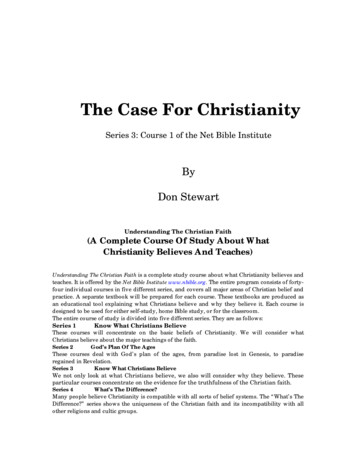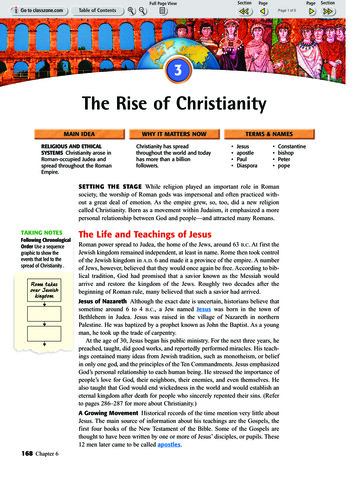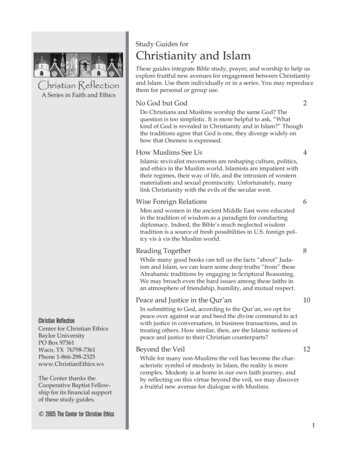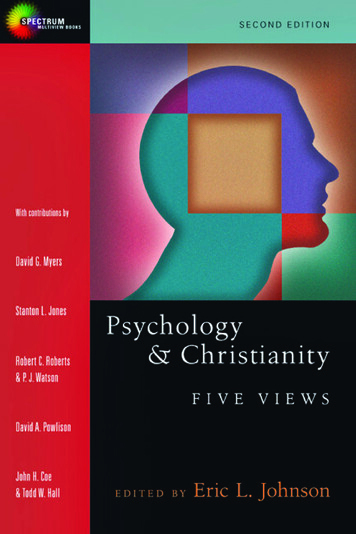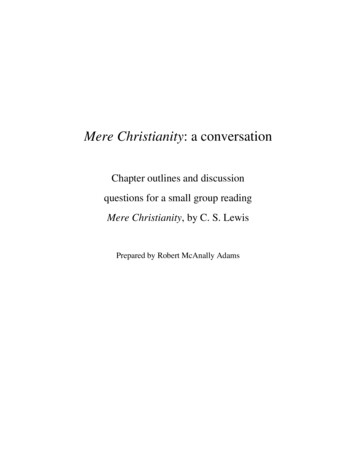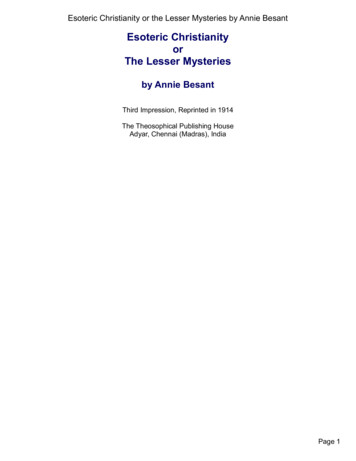
Transcription
CHAPTER 11CHRISTIANITY AND THETREATMENT OF ADDICTION:AN ECOLOGICAL APPROACHFOR SOCIAL WORKERSJason Pittman and Scott W. TaylorMost people can describe at least one instance of how alcohol and drugaddiction has had a negative impact on their own lives or the lives of peoplethey love. Children today, regardless of age or ethnicity, grow up in a societywhere access to drugs and alcohol is extremely easy. Parents who misusealcohol and drugs also influence how their children perceive and understand the use of alcohol and drugs. At a Christian ministry conference recently, participants were asked to share how drugs and alcohol had personally affected their lives, or the lives of people they know. Nearly everyone inattendance shared stories about their sons and daughters, aunts and uncles,mothers and fathers, and grandparents whose lives were negatively impacted by addiction.According to the National Council on Alcohol and Drug Addiction(2000), 10,000 deaths annually were attributed to alcohol abuse, as wellas an additional 10,000 deaths to illegal drug use, making alcohol anddrug addiction the third leading cause of preventable mortality in theUnited States. Furthermore, Gallup (1999) suggested that addiction is acommon issue involved in most of the following social problems: “murder and lawlessness, highway deaths, suicides, accidental deaths, injustices, hospitalizations, poor school performance and dropout, job absenteeism, child and spouse abuse, low self-esteem, and depression” (p.xi). Addiction is a serious problem, and it is imperative that we continue to try to understand its impact, not only in the United States, butin the entire world.Professionals working in the field of addiction treatment and laypersons helping from a Christian perspective have struggled with howbest to assist addicts. For example, Gray (1995) noted that most peopledealing with addiction are also struggling in many other areas of life.Social workers need to advocate for an eclectic approach that involvesthe contributions of many disciplines. An eclectic approach includes“models of interventions strategies and approaches, modalities of inter193
194Jason Pittman and Scott W. Taylorvention, organized conceptualizations of client problems or of practice,sets of practice principles, practice wisdom, and even philosophies ofpractice” (Abbott, 2000, p. 27).This chapter attempts to provide insight into the main issues regardingan informed eclectic approach. In the first section, we discuss the generalfield of addiction treatment, define addiction for the purpose of this chapter, provide a summary of addiction etiology theories, and discuss relevanttreatment interventions. The second section is a discussion concerning theinteraction of Christianity and addiction historically, with particular emphasis on the contribution of pastoral theology and Christian treatmentprograms. The chapter concludes by emphasizing that social workers shouldutilize an eclectic approach when helping addicts, while integrating thecontributions of addiction etiology theories and treatment interventions.Brief HistoryIn the United States, the nation’s first settlers had to deal with issuesrelated to drug and alcohol abuse. They drank more beer than water because of the lack of safe drinking water (Van Wormer, 1995). In the eighteenth century, distilled spirits became available to the masses and contributed to drunkenness at all class levels. People viewed alcohol and drugaddiction as a moral problem, resulting from sinful behavior and moralweakness in the individual. Society treated addicts very poorly, and theyfaced condemnation, guilt, shame, and many times ostracism (Morgan, 1999,p. 4). The term “alcoholic” was first used by the Swedish physician MagnusHuss in 1849. He defined alcoholism as “the state of chronic alcohol intoxication that was characterized by severe physical pathology and disruptionof social functioning” (White, 1998, p. xiv).Within the last hundred years, we have seen a major shift in howsociety perceives addiction. During the temperance and prohibitionmovements people tried to eliminate alcohol completely, believing thatif alcohol were illegal, then addiction would cease to exist. Later, withthe help of scientific research, the medical field began identifying addiction as a disease, considering the etiology to be strictly biological (VanWormer, 1995). It was during the early 1900s when Huss’s term “alcoholic” began to be circulated within professional circles, and in the 1930’s,Alcoholics Anonymous (AA) launched the term into widespread use.By 1944, the U.S. Public Health Service identified addiction as the fourthlargest health concern in the nation (Strung, Priyadarsini, & Hyman, 1986).The professional, medical, and research communities began to mobilizeand to create the new field of addiction treatment through the following:work of pioneers like E.M. Jellinek and Mark Keller; organizations such as
Christianity and the Treatment of Addiction195the National Committee for Education on Alcoholism, Research Councilon Problems of Alcohol; the Summer School of Alcohol Studies at Yale; andvolunteers like Marty Mann and her National Council on Alcoholism (Morgan, 1999; Royce, 1981; White, 1998). The first major step in shaping thefield of addiction treatment and counseling occurred when the AmericanMedical Association accepted the disease concept of alcoholism in 1956.One year later, the World Health Organization accepted the concept of alcoholism as a pathological condition.By 1960, society began debating how best to define alcoholism whileover 200 definitions circulated in various helping arenas (White, 1998).Professionals began to include other drugs and behaviors besides alcohol in the field of addiction, causing the debates to continue throughthe end of the 20th century. Today, the American Psychiatric Association(APA) uses the term “substance related disorders” to be inclusive of abroad range of problems associated with alcohol and drug usage (American Psychiatric Association, 2000). In this chapter, we will use the termaddiction earlier defined by APA as the state of being “compulsively andphysiologically dependent on a habit-forming substance” (McNeece &DiNitto, 1998, p. 23).Addiction Etiology TheoriesThe 1960s-1980s was a time of growing research and developmentconcerning addiction studies in the broad areas of psychology, psychiatry, and social work. Today, there are a number of theories to explainaddiction, and these theories are as varied as the number of definitionsof addiction (McNeece & DiNitto, 1998). We will provide a brief summary of the following broad areas of etiology theory: moral, biological,psychological, sociocultural, and multi-causal.Historically, the moral theory has described addiction as a result of“humankind’s sinful nature” (McNeece & DiNitto, 1998). Fingarette andPeele (as cited in McNeece & DiNitto) provide the contemporary equivalent of the moral theory. These theorists, however, do not suggest that addiction is caused by sinful nature; instead, addiction is a result of bad choices.We place these theorists in the moral model because their primary premiseis that addiction is cured by the simple choice of abstinence.Biological theories assume addicts are “constitutionally predisposedto develop a dependence on alcohol or drugs” (McNeece & DiNitto,1998, p.27). These theories emphasize the physiological sources of addiction such as genetics or neurochemistry. Genetic research is not suggesting that people are genetically determined to be addicts. Instead, itpoints toward people as being predisposed to addiction. Neurochemis-
196Jason Pittman and Scott W. Taylortry is divided into two theories: brain dysfunction and brain chemistry.These theories argue that biochemical changes taking place in addictsmay cause irreversible loss of control during the use of alcohol or drugs.Research suggests that certain people have the propensity to be unableto control their usage once they start. This lack of control may be due toheredity or actual changes that occur within the body because of thedrug interacting with the brain (Clinebell, 1990; Leshner, 2001).Psychological theories include a broad range of theories that havevery different outlooks on the cause of addiction. For example, cognitive-behavioral theories suggest several reasons for addicts taking drugs:to experience variety, desire to experience pleasure, or avoidance of withdrawal symptoms (McNeece & DiNitto, 1998). In addition, psychodynamic and personality theories look to underlying personality issues,hoping to explain the causes of addiction. These explanations vary greatlyand may consist of coping with painful experiences, guilt, loneliness,conflict, or low self-esteem (Clinebell, 1990).Sociocultural theories emphasize the importance of social attitudestoward addiction and link those attitudes surrounding alcohol and drugsas being the cause of many people’s decision to start abusing drugs oralcohol (Ciarrocchi, 1993). Theorists categorize sociocultural theoriesinto three areas that focus on different environmental factors found insociety and culture (McNeece & DiNitto, 1998). For example, theoristsargue that European countries have a much lower rate of alcoholism ascompared to the U.S. because of their tolerant views on drinking andintolerant views on drunkenness.Addiction is a very complex disorder that affects all aspects of one’slife. Professionals in the last sixty years have provided extensive researchand literature in the field, attempting to explain the root causes of addiction. Unfortunately, research does not provide one simple cause ofaddiction. Theorists, however, have proposed two models that attemptto include multiple etiology theories of addiction. Pattison and Kaufman(as cited in McNeece & DiNitto, 1998) offered a multivariate model inthe early 1980s that encompassed a multitude of causes of addiction.Health care and human service professionals, however, have advocatedfor the public health model. This model attempts to encompass manydifferent possible causes of addiction and involves looking at the interaction of the agent, host, and environment.Addiction Treatment InterventionsThere are a variety of interventions available to treat individualssuffering from addiction. For this chapter, intervention is conceptual-
Christianity and the Treatment of Addiction197ized in three ways: self-help groups, professional treatment programs,and counseling techniques. Alcoholic Anonymous (AA) is an exampleof a spiritual based self-help. They have attempted to bypass the problems of etiology and move into offering to alcoholics and helpers a pragmatic program of recovery that is based on the person’s spiritual life andunderstanding of a higher power. Therefore, many people today mistakenly refer to AA as a treatment program instead of a self-help group.AA started in the 1930s by two alcoholics trying to help each other stopdrinking. It was one of the pioneering self-help groups and quickly became a widespread movement. In addition, AA was instrumental in promoting the labeling of alcoholism as a disease. However, AA itself didnot advocate a strict disease model. It was simply a fellowship of peoplewith a common desire to stop using alcohol and drugs, and findingsobriety by “working” through a twelve-step program.As of January 2001, AA reported over 100,000 groups worldwidewith membership totaling over 2.1 million people (General Service Office, 2001). Although one of the hallmarks of AA is non-professionaltreatment, most professional treatment centers have integrated AA’s ideasinto the core of their addiction treatment programs (Van Wormer, 1995).In fact, Brown, Peterson, and Cunningham (1988) reported 95% of U.S.treatment centers are requiring, or have access to, AA meetings in theirtreatment programs.Interventions can also include professional treatment programs suchas outpatient or inpatient clinics or hospitals as well as long-term residential facilities. In the U.S., alcohol and drug treatment systems provided over 15,000 federal, state, local, and private programs that served760,721 clients in 1999 (Office of Applied Studies, 1999). The Minnesota model of treatment, introduced by the Hazelden Treatment Centerin Minnesota in the 1940s, combined AA’s twelve-steps with psychologically based group therapy (Van Wormer, 1995). This model gainedpopularity in the 1970s and is the predominant model used in treatment centers today.There are a multitude of interventions available to clinicians treating addicts based on counseling techniques and theories, many of whichare based on the etiology theories discussed in the previous section.Similar to how researchers have proposed that one etiology theory isnot sufficient, they have also suggested that there are strengths in manyof the counseling interventions. In fact, Miller, et al. (1995) argued intheir methodological analysis of outcome studies that “there does notseem to be any one treatment approach adequate to the task of treatingall individuals with alcohol problems” (p. 32).
198Jason Pittman and Scott W. TaylorTranstheoretical ModelProchaska, DiClemente, and Norcross (1992) began to study howpeople change in psychotherapy. They realized that the hundreds ofoutcome studies did not offer insight into the common principles thatwere allowing the change to occur. These researchers spent years analyzing and researching the processes that people go through when theychange and the corresponding processes therapists use to facilitate thatchange. They developed the Transtheoretical Model that consists of twoimportant interrelated theories for practice: the stages of change andthe processes of change.In the first part, Prochaska, et al. (1992) suggested that the stages ofchange (see table 1.0) do not necessarily progress in a linear nature, butbecause of how common relapse is in addiction, addicts usually follow aspiral pattern of change. Abbott (2000) noted that, “not every one completes the cycle. Some recycle numerous times; others stay in one or morestages of change, never exiting” (p. 117). Prochaska, et al. explained that“the stage of change scores were the best predictors of outcome; they werebetter predictors than age, socioeconomic status, problem severity and duration, goals and expectations, self-efficacy, and social support” (p. 116).The Transtheoretical Model also stresses the importance of matchingthe processes of change to the stage of change. Prochaska, et al. (1992)noted that past addiction treatment’s poor success rates were in part dueto treatment centers not having tailored their therapeutic approach tomatch the clients’ stage of change (see table 1.0). Abbott (2000) suggested that when the social worker is choosing a process of change andaccompanying methods and techniques, it is best to consider the client’s“age, personality characteristics, cultural factors, lifestyle, previous experiences with therapy, the severity of the ATOD [alcohol, tobacco, otherdrugs] problem, and available environmental resources” (p. 120).Christian Approaches to Etiology and InterventionThis section explores the development of Christian approaches to etiology and treatment of addiction. We will also highlight the significance ofChristianity in the development of Alcoholic Anonymous. Christianity hasstruggled with the topic of addiction, because it has historically characterized addiction as simply a sinful choice. This has created barriers betweenChristians attempting to provide a theological contribution to the field ofaddiction treatment and the secular community.In the late 1800s, a religious experience was viewed as the antidote for addiction (White, 1998). Many addicts were proclaiming that
Christianity and the Treatment of Addiction199Table 11Stages of Change in Which Particular Change Processes are Most UsefulStages of onMaintenanceProcesses of ChangeConsciousness raisingSocial liberationEmotional Environmental controlHelping relationships1 Source: Table 1 from Changing for Good (1994) by James O. Prochaska, John C.Norcross and Carlo C. Diclemente. Reprinted by permission of Harper Collins Publishers Inc.God took away their addiction in religious revivals. These revivalsprovided entrance for addicts into other social groups such as lodges,churches, tent meetings, missions, and informal helping resources. Theemergence of an urban society significantly contributed to the increasein the numbers of Christian approaches to alcoholism recovery. Theareas in cities where vagrants and destitute alcoholics made their homeswere labeled “Skid Rows” (p. 72). These areas were becoming majorproblems for civic leaders, and chronic addiction was seen as the primary problem.In 1826, David Nasmith started a rescue mission in Glasgow, Scotland. The name “rescue mission” implied that the organization wouldrescue persons from “Skid Rows” by providing temporary shelter, food,and other assistance. Jerry McAuley and Samuel Hadley started similarrescue missions in the U.S. to address the problems associated with addiction and “Skid Rows” (White, 1998). These pioneers were heavily influenced by protestant evangelists who preached that addiction was a sinand emphasized the conversion experience as the cure for addiction. Bythe early 1900s, the rescue mission movement had spread to most of themajor cities in the U.S. (Bakke, 1995). Currently, there are almost 200rescue missions in the U.S. that have treatment programs.Salvation Army became the most extensive urban Christian approach
200Jason Pittman and Scott W. Taylorin helping addicts (White, 1998). William Booth started Salvation Armyin 1865 in London, England, and the organization expanded to the U.S.in 1880. Booth attracted addicts by providing them with food and shelter and suggested that the cure for addiction would involve “Christiansalvation and moral education in a wholesome environment” (White,p. 74). By 1900, Salvation Army had spread to over 700 U.S. cities. Today, Salvation Army has 152 centers in the U.S. serving over 15,000addicts annually (Peters, 1980; Salvation Army, 2002).The early 20th century also saw an emergence of professional viewson religion and addiction recovery. In 1902, William James, a Harvardpsychologist and medical doctor, wrote The Varieties of Religious Experiences (White, 1998). This book explored the role of religious conversion as the cure for addiction, describing religious transformation asbeing either a sudden or a gradual process. James wrote about the powerthat conversion has on removing the cravings for alcohol and providinga new perspective or outlook for the addict’s life. These ideas highlyinfluenced the later developments of AA.Another example of a Christian presence in the addiction field wasseen when the Emmanuel Church Clinic in Boston opened in 1906 forthe treatment of various psychological disorders (White, 1998). Theseearly clinicians attempted to integrate religion, medicine, and psychology in their treatment for addiction. This program was quite differentfrom Salvation Army or rescue missions. Emmanuel’s treatment was thefirst to focus on psychologically based group and individual counseling. White suggested that this program “foreshadows the current use ofspirituality in addiction treatment” (p. 100). Their use of self-inventoryand confession was influential in the development of the Oxford Group,a Christian evangelical group, and later AA. The Emmanuel clinic discontinued its treatment program after the death of one of the primaryfounders, Rev. Dr. Elwood Worcester, in the 1940s.Alcoholics Anonymous is one of the most influential approachesrooted in Christianity. AA does not align itself with any religious group,church, or organization, it understands addiction to have biological,psychological, and social influences, but primarily offers a spiritual approach to recovery (Hester & Miller, 1995). Christian concepts, however, are inherent in AA’s twelve-steps, and these concepts have had alarge impact on the development of various twelve-step programs.The founders of AA, Bill Wilson and Dr. Bob Smith, began as membersof the Oxford Group (White, 1998). The Oxford Group movement beganon college campuses in England and spread quickly in the U.S. Clinebell(1998) suggested “it was an attempt to bring vital, first-century Christianity into the lives of people, challenging them to live by certain ethical abso-
Christianity and the Treatment of Addiction201lutes and motivating them to change others” (p. 273). The Oxford Groupused six steps to accomplish this purpose. In 1939, Wilson and “Dr. Bob”took the ideas from these six steps and adapted them specifically to theneeds of alcoholics, thereby, creating the twelve-steps of AA.The idea of AA’s Twelve-Steps is that alcoholics cannot overcomeaddiction on their own. They must turn their lives over to a higherpower and seek a spiritual path to recovery as the only way to gaincontrol of their addiction (Hester & Miller, 1995). It is important tonote that the Twelve-Steps are not a requirement for AA membership;they are the steps the founding AA members took to obtain and maintain sobriety and are “suggested as a program of recovery” In addition,AA stresses that these principles are primarily “guides to progress” andmembers “claim spiritual progress rather than spiritual perfection” (Alcoholics Anonymous, pp.59- 60).Step one suggests that alcoholics should admit they are “powerlessover alcohol – that [their] lives had become unmanageable.” Step twobegins the process of believing that a Higher Power can help them, whileStep three suggests they need to make a “decision to turn [their] willand [their] lives over to the care of God as [they] understand Him.” InStep four, alcoholics make a “searching and fearless moral inventory of[themselves]” (Alcoholics Anonymous, p. 58). Then, Step five suggeststhat alcoholics should admit to “God, to themselves and to anotherhuman being the exact nature of their wrongs.” Step six asks alcoholicsto be ready for God to help them with their character defects, and Stepseven encourages alcoholics to ask “Him to remove [their] shortcomings.” In Step eight, alcoholics make “a list of all persons we had harmed,and become willing to make amends to them all” (Alcoholics Anonymous, pp. 58-59). Subsequently, Step nine encourages members to makeamends with those people.The final three maintenance steps provide suggestions for alcoholics tomaintain sobriety. Step ten requires alcoholics to be continually responsiblefor their negative behavior and promptly admit when they are wrong. Stepeleven emphasizes that alcoholics must continue in spiritual growth throughprayer and meditation with the goal of being knowledgeable of God’s willfor their lives and the “power to carry that [will] out.” Finally, in Step twelve,once alcoholics have completed the other steps and have had a “spiritualawakening,” they are encouraged to help other alcoholics through that sameprocess (Alcoholics Anonymous, pp. 58-60).When Wilson and “Dr. Bob” created the twelve steps, they purposelyavoided any direct reference to Jesus Christ, and this omission upsetmany Christians (Hardin, 1994). They thought that the anonymity ofGod in the twelve steps was strategically important. This generic form
202Jason Pittman and Scott W. Taylorof spirituality and the traditions of AA have kept it from being an organized religion. However, it is important to note that both AA and organized religions share a “moral and transcendent perspective; an emphasis on repentance; ultimate dependence and conversion experience; scriptures and a creed; rituals; and a communal life” (Peteet, 1993, p. 263267). Christians should not let the lack of direct references deter themfrom utilizing AA.The success and rapid growth of AA had an effect on the developmentof Salvation Army’s addiction treatment programs. By the 1940s, SalvationArmy began to separate their addiction treatment centers from their homeless shelters (White, 1998). They changed their programs in order to include “a broadening approach to treating alcoholism that integrated medical assistance, professional counseling, Alcoholics Anonymous, and Christian Salvation” (White, p. 75). Salvation Army officers were also involvedin the initial Summer School of Alcohol Studies at Yale University, and, bythe 1950s, Salvation Army was hiring social workers to help implement amore professional structured therapy program.Rescue missions and Salvation Army historically have received themost criticism for their moralistic views on addiction, viewing that addicts just need to “get saved” (Clinebell, 1998). As described above,however, Salvation Army has attempted to integrate clinical models witha Christian perspective. Furthermore, research has shown that Salvation Army has comparable success rates to other secular treatment centers (Bromet, Moos, Wuthmann, & Bliss, 1977; Gauntlett, 1991; Katz,1966; Moss, 1996; Zlotnick & Agnew, 1997).In recent years, rescue missions have also begun to integrate clinicalmodels with their Christian perspective. Rescue missions, overall, still emphasize Christian conversion as the primary solution to recovery more thandoes the Salvation Army. Additionally, Salvation Army primarily uses AAwhile the association of rescue missions is a sponsor of Alcoholics Victorious, a network of explicitly Christian twelve-step support groups. Unfortunately, little research has been conducted on the evaluation or treatmentapproach of rescue missions (See Fagan, 1986).In 1958, David Wilkerson, a Pentecostal preacher, started Teen Challenge, a more explicitly Christian salvific approach to addiction treatment. In his book, The Cross and the Switchblade, Wilkerson shares hisexperiences in ministering to the youth and the gangs in New York City.Teen Challenge views addiction as primarily an issue of sin, and thesolution is a conversion experience where the person is “‘born again’ byaccepting Jesus Christ as ‘personal Savior’” (Muffler, Langrod, & Larson,1997, p. 587). Teen Challenge currently operates 120 centers in theU.S. and 250 centers worldwide for its 12 to 18 month residential pro-
Christianity and the Treatment of Addiction203gram (Teen Challenge, 2000). Ironically, only six Teen Challenge centers serve teenagers. Many programs also have changed their name tobe more inclusive for all ages (e.g., Life Challenge in Dallas, TX). Interestingly, Muffler, Langrod, & Larson (1997) argued that the rates ofsuccess for Teen Challenge have been grossly over stated; instead of86%, they suggest that success rates are closer to 18.3%, similar to the15% success rates of secular therapeutic communities.Other arenas of Christian treatment have developed over the years.Saint Marr’s Clinic in Chicago, the Christian Reformed Church’s Addicts Rehabilitation Center in New York, Episcopal Astoria Consultation Service in New York, and East Harlem Protestant Parish’s ExodusHouse (White, 1998) are some examples. Muffler, et al. (1997) notedthat Protestants and Catholics address addiction at the denominationalor diocesan level through organizations like Catholic Charities orLutheran Social Services. Also, there are Christian treatment programslocated within hospital settings (e.g., Rapha) or outpatient clinics (e.g.,New Life Clinics or Minirth Myer Clinics) designed for individuals withinsurance or other means to pay for treatment.In addition, there are thousands of smaller Christian treatment programs throughout the U.S. In the state of Texas, for example, of the approximately 115 registered faith-based providers, the larger Christian organizations mentioned in the paragraph above account for fewer than tenof the providers. The majority of the remaining organizations are localChristian treatment facilities. Furthermore, the Christians in Recovery’s(2002) database contains over 2500 Christian ministries, organizations,local groups and meetings worldwide that deal with addiction. The Substance Abuse and Mental Health Services Administration, a governmentagency, does not track faith-based or Christian programs in their databaseof over 15,000 treatment facilities. In fact, they claimed it was difficult toeven define faith-based programs because a facility may be funded by areligious organization, but not have inherently religious teachings (L.Henderson, personal communication, April 15, 2002).Pastoral Theology’s ContributionChristian approaches to addiction treatment vary based on theirtheological interpretation of Biblical passages. Furthermore, a dichotomyin addiction treatment developed based on those particular theologicalapproaches to addiction. Some approaches have focused on addictionsimply as sin, and “getting saved” was the primary solution. Other groupstook a more liberal approach to addiction as some theologians werebeginning to shift their thoughts to what the Bible says about human
204Jason Pittman and Scott W. Taylornature, our relationship with God, and God’s purpose for our lives andapplying it to addiction treatment. A full historical account of the development of pastoral theology’s contribution to the addiction treatmentfield is not within the scope of this section. However, a brief historicalsummary is provided with particular emphasis on several theologians’contributions to the understanding of addiction.Protestant pastoral theology began in the 1800s in Germany, butthe American pastoral theology movement, which focused more on thepsychology of religion, emerged in the 1930s with pioneers such as AntonBoisen, Richard Cabot, and Russell Dicks (Burck & Hunter, 1990). Theyprovided insight into the relationship between religion and health andcontributed a large amount of literature concerning psychological pastoral care and counseling to the field. These pioneers drew
According to the National Council on Alcohol and Drug Addiction (2000), 10,000 deaths annually were attributed to alcohol abuse, as well as an additional 10,000 deaths to illegal drug use, making alcohol and drug addiction the third leading cause of preventable mortality in the United States. Furthermore, Gallup (1999) suggested that addiction is a



